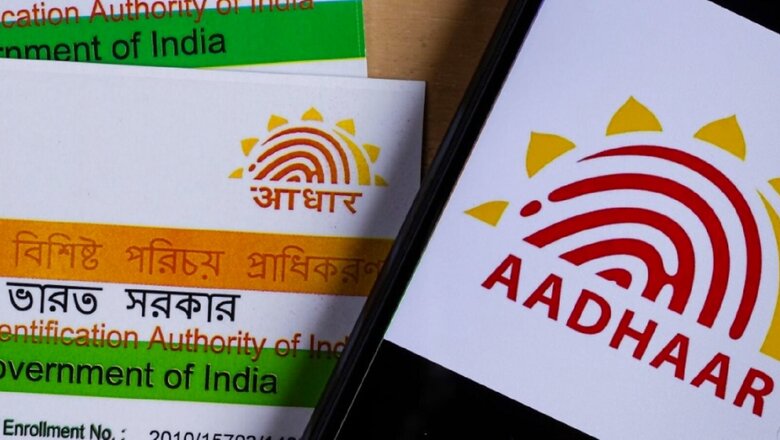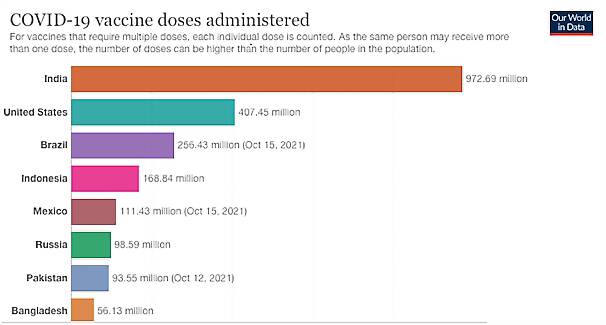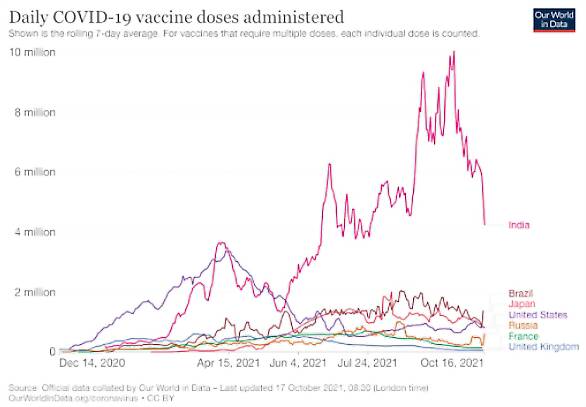
views
The Central government on Wednesday wrote a letter to The Economist rubbishing observations made by the publication in an article published on October 16.
“Titled ‘India’s high-tech governance risks leaving behind its poorest citizens’, the article betrays a severe lack of journalistic diligence and seem to have relied on guided reporting, resulting in a biased, and inaccurate piece which, in many instances has contradicted even the past reports in your own esteemed publication,” read the letter.
Here’s what the government’s point-by-point rebuttal of the report said:
The Economist wrote: “Administrative infrastructure such as Aadhaar has propelled such conveniences as digital payments, internet shopping and online schooling. Yet precisely because of India’s size and poverty, tens of millions still are left out—because they are poor illiterate, disabled, lack electricity, do not possess a smartphone or cannot connect to a mobile or Wi-Fi network.”
Centre’s reply: The total number of Aadhaar card holders above 18 years of age has reached 129.48 crore (1 crore is 10 million) as on 21st June 2021. As per UIDAI data in the last one year, the UIDAI has issued around 36 crore new Aadhaar cards to the adult population. In this period the highest number of Aadhaar cards was issued in January 2021 when 53.4 lakh (5.34 million) new Aadhaar card holders were added to the list of Indian population having digital identity.
The Economist on 5th September 2020 published an article stating:
Creating a digital ID system is hard and expensive. Yet India, a gigantic and largely poor country, has managed it. Its Aadhaar biometric system has created digital identities for 1.3bn people… it has streamlined government services and massively reduced fraud. If rural Indians can prove who they are online, it is scandalous that many Brits and Americans cannot.
https://uidai.gov.in/images/resource/Economist_SEP_5_2020_Aadhaar.pdf
The Economist wrote: “With no phone, no registered postal address and no record of her birth date, Ms Devi was unable to retrieve her unique number.”
Centre’s reply: “In such cases, the resident can easily retrieve his/her Aadhaar card by visiting the nearest Aadhaar Enrolment Center. The resident may be provided with Aadhaar number after furnishing his/her demographic details and authenticating the biometrics. In case, if demographic details like address, date of birth, phone number etc. is also not available, then, the resident can visit the nearest Aadhaar Seva Kendra or concerned UIDAI, Regional Office.”
The Economist wrote: “There are gaping holes in other government schemes as well. India’s covid-19 vaccination campaign, launched in January, quickly sagged, and not only because the government failed to order enough doses. Slots for shots could be booked only via CoWin, an online service. This proved easy for digitally literate people with at least some English. Most of those without such talents—the vast majority of Indians—had to wait until June, when the government quietly started.”
Centre’s reply: “Languages on Co-WIN platform: Apart from English and Hindi, 10 regional languages options are available on Co-WIN platform. These include Assamese, Bengali, Gujarati, Kannada, Marathi, Malayalam, Odia, Punjabi, Tamil, and Telugu.
Registration Assistance: Online registration and prior booking of appointment is not mandatory to avail vaccination services. Apart from online registration and appointments, Co-WIN offers the following modes for registration and vaccination of beneficiaries:
On-site or walk-in registration and vaccination for people (both individuals and groups of individuals) belonging to facilitated cohorts such as people who don’t have access to internet or smart phones. The vaccinators who operate the vaccination session do the on-site registrations. The beneficiary is not required to use the Co-WIN digital interface in such cases.
Assisted registration through Common Service Centers (CSCs)
Assisted registration through 1075 helpline/Call center.
Special sessions for facilitating vaccination of people who don’t have any of the specified identity cards, wherein all vaccination is done through on-site registration by the vaccinator.
Facility for organizing special session for Near-to-Home vaccination sessions for elderly and persons with disabilities, wherein all vaccination is done through on-site registration by the vaccinator.
Features for reserving vaccinations slots for second dose to ensure that people do get the second dose of vaccination within the recommended period after the first dose.
Any person, who has been registered on Co-WIN through online mode, can also avail on-site vaccination.
Furthermore, on-site registrations have been the predominant mode of registration of beneficiaries on Co-WIN since the launch of the National Vaccination Drive on 16.01.2021.
Pace of vaccination in comparison with other countries: India has administered the highest number of COVID vaccine doses in the world. As of 19th October morning, India has administered more than 99 crore (99 million) doses of COVID vaccine and is likely to touch the 100 Crore or ONE Billion doses shortly.
As per the data available on Our World in Data, the US follows India with over 40 crore (400 million) COVID vaccination, and Brazil has administered 25.6 crore (256 Million) COVID vaccine doses.

Similarly, as per the data available on Our World in Data, in the average pace of daily COVID vaccination, India again leads the table with over 4-6 million daily doses (rolling 7-days average). Countries like US, France, UK, Brazil and Russia are all under 1-2 million daily doses (rolling 7-days average). ”

Source: https://ourworldindata.org/covid-vaccinations
The Economist wrote: “The (Anganwadi) workers say the app is hard to use. It is only in English, which most do not understand, and takes up so much memory it crashes their cheap smartphones. Many do not even have a phone, or electricity or mobile reception in their villages. What was wrong with the old written ledgers they carefully kept for years, they ask? The change is that the government now wants more control and surveillance.”
Centre’s reply: “The Poshan Tracker application is provided in 22 languages. In the application, an AWW has to enter only the name of the beneficiary in English. All other fields can be viewed in the local language. The App can easily be downloaded in any Android VI and above phone. Poshan Tracker is a very light on memory using only 14 mb space and the smartphones provided to Workers by the State Govts can easily handle several such apps. The data of beneficiaries resides on the servers, and does not use phone memory for the same.
The proof of Trackers robustness lies in the fact that as on date, it has been downloaded by more than 1.27 million workers, who are feeding data in it. Another 160000 would start using the same as soon as concerned State Govts provide the smart phones to them (within next 2-3 months). This would ensure 100% coverage of the Anganwadi ecosystem.
The Poshan Tracker Application has been introduced for convenience of the AWW convenience by doing away with the burden of maintaining physical registers. Application optimization is conducted regularly to make it effective.
To support data entry in case of network issues, an offline module has been introduced in the Tracker. It provides the flexibility of accessing data anytime, anywhere and helps to check the real time status of service delivery to beneficiaries at Anganwadi centers. The objective of the digital tool is to improve governance, promote transparency, efficiency and timely delivery of services under the Scheme.
The Poshan Tracker along with use of Growth Monitoring Devices, provided for the first time under Poshan Abhiyaan, is providing real time and correct information about prevalence of malnutrition in the poorest of the poor in the society, who are the beneficiaries of the scheme. This is helping in correct identification and treatment of underweight, stunted and wasted children requiring additional nutrition support and bringing them to normal levels.
In near future, all services related to health and nutrition of pregnant women and lactating mothers; children up to the age of 6 years; and adolescent girls will be integrated with the Poshan Tracker platform.”
The Economist wrote: “In Anganwadi with an extra helper, severe stunting dropped a remarkable 42%. Yet whereas the government’s operating budget for Anganwadi—meaning food and salaries—has stayed flat, its outlay on tech has soared. In its rush to become a modern, digital economy, India is leaving behind those who might benefit the most.”
Centre’s reply: “The Anganwadi Services team comprises the Anganwadi Workers, Anganwadi Helpers, Supervisors, Child Development Project Officers (CDPOs) and District Programme Officers (DPOs). Anganwadi Workers and helpers are the ladies selected from the local community, and are community based frontline honorary worker of the Anganwadi Services Programme. The Scheme today operates through a network of 7075 fully operational Projects and more than 1.38 millon AWCs as on March, 2021.The services are currently being provided through more than 1.33 million Anganwadi Workers and 1.18 million Anganwadi Helpers. The Anganwadi Workers are provided with the assistance of Helpers to enable them to fulfill the objectives under the schemes effectively.
The Scheme provides universal coverage to all children in 0-6 year age group; Pregnant Women & Lactating Mothers and out-of-school Adolescent Girls. The Government of India spends Rs 201 billion on Anganwadi Services including supplementary nutrition, whereas the spend on technology is only Rs 500 million. The budgetary allocations under the Scheme have always increased in the past years and there has never been a decreasing trend. Compared to 2013-14 (Rs 163 Billion) the outlay on the Scheme has gone up by 23.25 % (Rs 201 Billion) in 2021-22.
The government of India undertakes revision of the honorarium of AWWs and AWHs from time to time and has enhanced the honorarium w.e.f. 01.10.2018 by nearly 30% and also introduced performance linked incentive to AWWs/AWHs. In addition to the honorarium and other incentives paid by the Government of India, the respective State Govts also give additional monetary benefits to these workers.”
The Economist wrote: “Recent surveys by Lokniti-CSDS, a polling group, show that four-fifths of Indian families use public food-supply schemes, of which 28% say they have been denied rations at some point owing to problems with Aadhaar. The biometric id has helped curb theft and corruption, but less so than non-tech reforms to the food system”
Centre’s reply: “The article misses some important facts about food security and the role of technology in ensuring rightful targeting of beneficiaries in India under the Targeted Public Distribution System (TPDS).
As part of the technology driven TPDS reforms, significant progress has been made at the national level during the past 6-7 years. These reforms inter-alia include digitization of all ration cards data (100% achieved in all States/Union Territories), Aadhaar seeding (>90% at the national level), installation of electronic Point of Sale (ePoS) devices at the FPSs for transparent distribution (~93% at the national level), portability of ration cards under One Nation One Ration Card (ONORC) plan (enabled in 34 States/Union Territories), etc.
As a key indicator, presently an average of almost 80%-85% of almost 43.5 LMT monthly; (522 LMT annual) allocated foodgrains to States/UTs under NFSA by this Department, are being consistently distributed to the beneficiaries through biometrically authenticated transactions every month across the country.
Moreover, in lieu of Aadhaar, Exception Handling Mechanisms (EHMs) are in place to deal with such cases and technical eventualities to ensure the subsidised foodgrains are delivered to intended beneficiaries with transparency. In any case, nearly 15%-20% of monthly allocated foodgrains at the national level are being distributed through non-biometric/Aadhaar authenticated transactions, which shows that there is no denial of foodgrains to genuine NFSA beneficiaries for want of Aadhaar, and the foodgrains are distributed without Aadhaar.
Additionally, during the ongoing COVID-19 crisis, the free-of-cost distribution of 5 Kg foodgrains per person per month (over and above regular NFSA entitlements) under the Pradhan Mantri Garib Kalyan Anna Yojana (PM-GKAY) has effectively doubled the quantity of monthly foodgrains for all NFSA beneficiaries in the country.
So far, under PM-GKAY (Phase I to IV) a total of almost 600 LMT of additional foodgrains have been allocated to the States/Unoin Territories (322 LMT during 2020 and 278 LMT during the year 2021), equivalent to about Rs. 2.07 Lakh Crore (USD 27 Billion) in food subsidy.
Further, concurrent evaluations being conducted by independent Monitoring Institutions (mostly IITs/IIMs and other leading institutions of the country) have shown almost 98% distribution of monthly allocated foodgrains to NFSA beneficiaries across the country, while independent survey conducted by Dalberg in various parts of the country has shown an average of nearly 94% beneficiaries have also received the free PM-GKAY foodgrains since April 2020, and has shown a very high level of satisfaction among the NFSA beneficiaries with regards to availability and distribution of both NFSA and PM-GKAY foodgrains to them.
It is also mentioned that as per extant instructions to all States/UTs dated 24.10.2017 and 08.11.2018, all States/UTs are advised to ensure that no genuine beneficiary shall be denied their quota of entitled (NFSA and PM-GKAY) foodgrains only for want of Aadhaar / no Aadhaar seeding with ration card / failure of biometric authentication / any technical failure in ePoS device including failure of biometric scanner, poor network, connectivity, or linking issues.”
Read all the Latest News , Breaking News and IPL 2022 Live Updates here.




















Comments
0 comment